Religion
|
The church is one of the strongest unifying forces in the community of Tignish.
The present church of Tignish, St. Simon & St. Jude, was the dream of Father Peter
McIntyre, the first resident pastor of Tignish. Today, the church is the focal point and civic heart of the historic Acadian-
Irish town of Tignish. From its steeple, atop the soaring buttressed tower,
peal out vigorously the bells of Tignish.

Large Bell
|
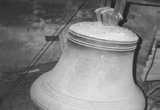
Smaller Bell
|
Back to Community
|
|
Convent
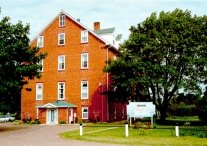 Tignish became a centre for girls' education when the Sisters of the Congregation of Notre-Dame
opened a day/boarding school in 1868. Along with the Convent schooling, there was a government
school for boys which became a First-Class school in 1879. This meant it could provide the
equivalent of two years of high school education for boys. Quite a few religious and
educational associations for adults were also organized in the last part of the 19th century
as well. These groups often sponsored lectures and other cultural activities. Members of the
Community of Tignish also organized plays and concerts to contribute to cultural life in
Tignish.
Tignish became a centre for girls' education when the Sisters of the Congregation of Notre-Dame
opened a day/boarding school in 1868. Along with the Convent schooling, there was a government
school for boys which became a First-Class school in 1879. This meant it could provide the
equivalent of two years of high school education for boys. Quite a few religious and
educational associations for adults were also organized in the last part of the 19th century
as well. These groups often sponsored lectures and other cultural activities. Members of the
Community of Tignish also organized plays and concerts to contribute to cultural life in
Tignish.
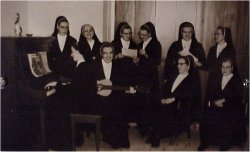
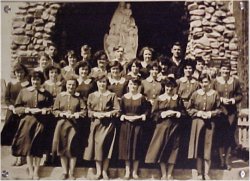
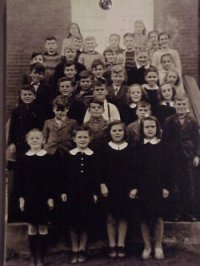
Back to Top
Establishment of the Church
 In 1801, the Acadian settlers, although very poor and without a priest, decided to build themselves
a log church. The church measured 30 x 25. Without the guidance of a priest, they would gather at the Church every Sunday morning
to read morning prayers, sing, and hear the Gospel.
In 1801, the Acadian settlers, although very poor and without a priest, decided to build themselves
a log church. The church measured 30 x 25. Without the guidance of a priest, they would gather at the Church every Sunday morning
to read morning prayers, sing, and hear the Gospel.
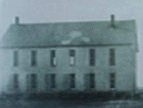 After being in operation for over 20 years, this church was replaced by a more substantial structure. It was
in 1826 when the new and much larger church was built. The church measured 60 x 45. In 1844, after Father Peter MacIntyre arrived, Tignish became a parish of its own with Father MacIntyre as its pastor.
Also in 1844, the interior of the church was changed substantially. By 1851, there was an organ placed in the church
by Father Peter MacIntyre. After the church had served "Tignishers" for more than 30 years, it was
hauled by a team of 80 horses to a location near the Dalton School, and here it served as the Tignish Grammar
School.
After being in operation for over 20 years, this church was replaced by a more substantial structure. It was
in 1826 when the new and much larger church was built. The church measured 60 x 45. In 1844, after Father Peter MacIntyre arrived, Tignish became a parish of its own with Father MacIntyre as its pastor.
Also in 1844, the interior of the church was changed substantially. By 1851, there was an organ placed in the church
by Father Peter MacIntyre. After the church had served "Tignishers" for more than 30 years, it was
hauled by a team of 80 horses to a location near the Dalton School, and here it served as the Tignish Grammar
School.
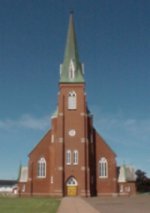 It was not until 1857 that the Church of St. Simon & St. Jude began to be constructed. The entire building was
constructed of domestic brick, with a steeple measuring 185 feet in height. This spectacular
steeple not only gives evidence to the Christian faith of Tignish, but it also is used as a landmark for many
fishers. Twelve amazing columns located in the church consist each of one large tree which
was cut from the Virgin Forest, located on the Centre Line Road. Young men were sent to cut
the enormous trees and to get them back to the church by way of bobsled and horses. Each tree needed
four bobsleds to escort it. This spectacular building was in its semi-completed stage in 1859 and was consecrated in 1860.
It was not until 1857 that the Church of St. Simon & St. Jude began to be constructed. The entire building was
constructed of domestic brick, with a steeple measuring 185 feet in height. This spectacular
steeple not only gives evidence to the Christian faith of Tignish, but it also is used as a landmark for many
fishers. Twelve amazing columns located in the church consist each of one large tree which
was cut from the Virgin Forest, located on the Centre Line Road. Young men were sent to cut
the enormous trees and to get them back to the church by way of bobsled and horses. Each tree needed
four bobsleds to escort it. This spectacular building was in its semi-completed stage in 1859 and was consecrated in 1860.
 In 1882, the finest musical instrument found in a Prince Edward Island church was installed.
This amazing organ cost only $ 2,400.00 and now is valued at close to a million
dollars. It contains 1,118 pipes ranging from a height of 3 inches all the way to 16 feet. The
pedal board is of the old type and is not concave radiating. The organ was pumped by hand until
the mid 1950s when electricity came to Tignish.
In 1882, the finest musical instrument found in a Prince Edward Island church was installed.
This amazing organ cost only $ 2,400.00 and now is valued at close to a million
dollars. It contains 1,118 pipes ranging from a height of 3 inches all the way to 16 feet. The
pedal board is of the old type and is not concave radiating. The organ was pumped by hand until
the mid 1950s when electricity came to Tignish.
The organ is built in exactly the same manner that the great organs of Europe played by J.S.Bach
were constructed. When a key is pressed, it activates a series of thin wooden sticks called
trackers which, by means of pivots and wires, finally open a valve so that air can enter a pipe,
or a series of pipes, and produce a sound. Hence, it is called a tracker action organ.
In 1888, it was decided that the original dark brown simulated-stone interior finish of the
church was too dull and dark, so preparations were made to raise the necessary $3,100.00 for
redecoration.
Later in that same year, the interior was first painted and decorated. The life size paintings of the 12 Apostles on the walls was done by the
famous Francois Xavier Edouard Meloche of Montreal. The stained glass windows and the impressive Stations of the Cross
were also installed upon completion of the building.
François Xavier Édouard Meloche was the foremost church painter of
his day. Meloche was a student of Napoléon Bourassa and had studied in France and Italy. He was
therefore well aquainted with the different styles of church decoration throughout the ages. Indeed,
Meloche had gained widespread public recognition by the means he used to teach his students. In a church no longer in use, which he rented as a studio space, each new class of students would be given the task of
decorating the church in a particular historic style. This would be painted out by the next
class of students and the public was then invited to view the results.
Assisted by a dozen of his students, Meloche spent several weeks in July and August of 1888
completely redecorating the church in various shades of pale greys. Two huge colored murals of
the Transfiguration and the Assumption of the Virgin flanked the sanctuary. On
the front walls of the side aisles were painted, in coloured false-relief, the two patron saints,
Simon and Jude, while in illusionary niches between the windows of the side walls, the
remaining apostles were painted in a sepia grisaille work.
In the side vaults where one would expect clerestory windows, large roundels that simulate
windows were painted. These all contain a number of sacred symbols, many of which appear to be
associated with images that occur in the Litany of the Blessed Virgin Mary.
 Painting of Apostles
Painting of Apostles
Yet another feature of the St. Simon & St. Jude Church are the amazing bells located high above the town
in the church's steeple, the largest of the bells weighing 2,100 pounds. The bells can be heard
ringing vigourously throughout the area.
Back to Top
Pastors of St. Simon and St. Jude Parish
1799-1803 L'Abbé de Calonne
1799-1803 L'Abbé Amable Pichard
1803-1812 Angus MacEachern
(First Bishop of Charlottetown)
1812-1818 L'Abbé Jean-Louis Beaubien
1818-1822 L'Abbé Joseph Étienne Cecile
1822-1828 Bernard Macdonald
(Second Bishop of Charlottetown)
1828-1843 Sylvain Ephrem Poirier
1843-1860 Peter McIntyre
(First resident pastor of Tignish & Third Bishop of Charlottetown)
1860-1861 André Roy
1861-1863 Dugald M. MacDonald
1863-1867 Dougald MacIsaac
1867-1923 Dugald M. MacDonald
1923-1931 Gregory MacLellan
1931-1956 John Archie Macdonald
1956-1971 Michael Rooney
1971-1975 Austin Bradley
1975-1977 Arthur Pendergast
1977-1980 Walter Reid
1980-1983 Edouard Cormier
1983-1990 Claude Shea
1990- Albin Arsenault
Back to Top
Pastor Photos
Rev. John A. Macdonald
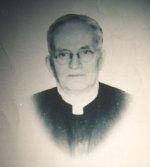 1931-1956
1931-1956
|
Fr. Albin Arsenault
 1990-Present
1990-Present
|
Fr. Walter Reid
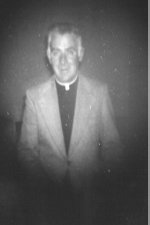 1977-1980
1977-1980
|
Fr. Michael Rooney
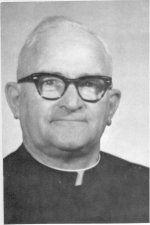 1956-1971
1956-1971
|
Fr. Arthur Pendergast
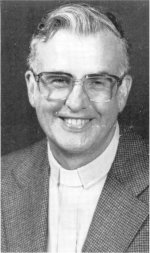 1975-1977
1975-1977
|
Eddie Cormier
 1980-1983
1980-1983
|
Back to Top
| 






 Tignish became a centre for girls' education when the Sisters of the Congregation of Notre-Dame
opened a day/boarding school in 1868. Along with the Convent schooling, there was a government
school for boys which became a First-Class school in 1879. This meant it could provide the
equivalent of two years of high school education for boys. Quite a few religious and
educational associations for adults were also organized in the last part of the 19th century
as well. These groups often sponsored lectures and other cultural activities. Members of the
Community of Tignish also organized plays and concerts to contribute to cultural life in
Tignish.
Tignish became a centre for girls' education when the Sisters of the Congregation of Notre-Dame
opened a day/boarding school in 1868. Along with the Convent schooling, there was a government
school for boys which became a First-Class school in 1879. This meant it could provide the
equivalent of two years of high school education for boys. Quite a few religious and
educational associations for adults were also organized in the last part of the 19th century
as well. These groups often sponsored lectures and other cultural activities. Members of the
Community of Tignish also organized plays and concerts to contribute to cultural life in
Tignish.
 In 1801, the Acadian settlers, although very poor and without a priest, decided to build themselves
a log church. The church measured 30 x 25. Without the guidance of a priest, they would gather at the Church every Sunday morning
to read morning prayers, sing, and hear the Gospel.
In 1801, the Acadian settlers, although very poor and without a priest, decided to build themselves
a log church. The church measured 30 x 25. Without the guidance of a priest, they would gather at the Church every Sunday morning
to read morning prayers, sing, and hear the Gospel.
 After being in operation for over 20 years, this church was replaced by a more substantial structure. It was
in 1826 when the new and much larger church was built. The church measured 60 x 45. In 1844, after Father Peter MacIntyre arrived, Tignish became a parish of its own with Father MacIntyre as its pastor.
Also in 1844, the interior of the church was changed substantially. By 1851, there was an organ placed in the church
by Father Peter MacIntyre. After the church had served "Tignishers" for more than 30 years, it was
hauled by a team of 80 horses to a location near the Dalton School, and here it served as the Tignish Grammar
School.
After being in operation for over 20 years, this church was replaced by a more substantial structure. It was
in 1826 when the new and much larger church was built. The church measured 60 x 45. In 1844, after Father Peter MacIntyre arrived, Tignish became a parish of its own with Father MacIntyre as its pastor.
Also in 1844, the interior of the church was changed substantially. By 1851, there was an organ placed in the church
by Father Peter MacIntyre. After the church had served "Tignishers" for more than 30 years, it was
hauled by a team of 80 horses to a location near the Dalton School, and here it served as the Tignish Grammar
School.
 It was not until 1857 that the Church of St. Simon & St. Jude began to be constructed. The entire building was
constructed of domestic brick, with a steeple measuring 185 feet in height. This spectacular
steeple not only gives evidence to the Christian faith of Tignish, but it also is used as a landmark for many
fishers. Twelve amazing columns located in the church consist each of one large tree which
was cut from the Virgin Forest, located on the Centre Line Road. Young men were sent to cut
the enormous trees and to get them back to the church by way of bobsled and horses. Each tree needed
four bobsleds to escort it. This spectacular building was in its semi-completed stage in 1859 and was consecrated in 1860.
It was not until 1857 that the Church of St. Simon & St. Jude began to be constructed. The entire building was
constructed of domestic brick, with a steeple measuring 185 feet in height. This spectacular
steeple not only gives evidence to the Christian faith of Tignish, but it also is used as a landmark for many
fishers. Twelve amazing columns located in the church consist each of one large tree which
was cut from the Virgin Forest, located on the Centre Line Road. Young men were sent to cut
the enormous trees and to get them back to the church by way of bobsled and horses. Each tree needed
four bobsleds to escort it. This spectacular building was in its semi-completed stage in 1859 and was consecrated in 1860.
 In 1882, the finest musical instrument found in a Prince Edward Island church was installed.
This amazing organ cost only $ 2,400.00 and now is valued at close to a million
dollars. It contains 1,118 pipes ranging from a height of 3 inches all the way to 16 feet. The
pedal board is of the old type and is not concave radiating. The organ was pumped by hand until
the mid 1950s when electricity came to Tignish.
In 1882, the finest musical instrument found in a Prince Edward Island church was installed.
This amazing organ cost only $ 2,400.00 and now is valued at close to a million
dollars. It contains 1,118 pipes ranging from a height of 3 inches all the way to 16 feet. The
pedal board is of the old type and is not concave radiating. The organ was pumped by hand until
the mid 1950s when electricity came to Tignish.





